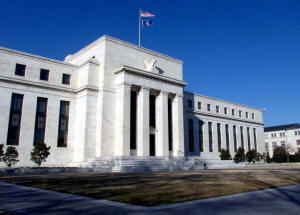Fed meeting minutes could hint at end of rate hikes
 Send a link to a friend
Send a link to a friend
 [August 16, 2023] By
Howard Schneider [August 16, 2023] By
Howard Schneider
WASHINGTON (Reuters) - The minutes of the Federal Reserve's policy
meeting last month may indicate on Wednesday how many policymakers feel
the U.S. central bank is done raising interest rates and whether
possible risks to the economy from the aggressive monetary tightening
have taken on more weight in their debate.
The Fed raised its benchmark overnight interest rate to the 5.25%-5.50%
range at the July 25-26 meeting, a step Fed Chair Jerome Powell said at
his post-meeting press conference may not be the last in an aggressive
round of rate increases that began in March 2022 to offset the fastest
breakout of inflation since the 1980s.
But Powell also said the "pieces of the puzzle" were beginning to fall
into place to push inflation lower, including improved supply chains, a
moderation in the demand for workers, and tighter lending conditions.
The minutes, which are due to be released at 2 p.m. EDT (1800 GMT), may
show how much faith different groups of Fed officials have in a
continued decline in inflation, or whether the bulk of them still feel
another rate increase is likely needed, as most of them did in their
last round of economic projections in June.

An additional quarter-percentage-point rate increase, whether at the
Fed's Sept. 19-20 meeting or later in the year, would be marginal in its
macroeconomic impact, a small addition to the 5.25 percentage points the
Fed has added to its policy rate over the 16 months ending in July.
It would, however, send an important signal to bond and stock markets
that are largely convinced the central bank is finished raising rates
and will now begin looking for the right moment to start cutting.
"There appears to be little consensus amongst policymakers regarding the
path ahead," wrote Citi analyst Andrew Hollenhorst, who said he will
look to the minutes for "the leading edge of a debate about the
appropriateness of keeping policy rates elevated even as job growth and
inflation have recently cooled."
'MIXED MESSAGING'
The minutes include references to how officials assess the economy, the
likely path of inflation, appropriate monetary policy, and the chief
risks to policymakers' outlook.

[to top of second column] |

The U.S. Federal Reserve building in
Washington, D.C./File Photo

The document, issued three weeks after a policy meeting, is always
at risk of seeming outdated and is often reiterative of points the
Fed chief makes in post-meeting press conferences, or overrun by
data that has come out in the meantime.
Powell, for example, confirmed at his press conference last month
that Fed staff had changed their forecast and removed the
expectation the economy would slip into recession, a point that
would otherwise have only been revealed in the minutes.
And whatever the debate among policymakers as of the July 25-26
meeting, data since then has confirmed a continued hiring slowdown
along the lines Fed officials have hoped might help cool the job
market, while the closely-watched personal consumption expenditures
price index excluding food and energy posted its first significant
drop since 2022. The core PCE index fell in June to 4.1% from 4.6%
in May, a fact only released after the Fed meeting, though
economists expected the decline.
Since the July meeting, Philadelphia Fed President Patrick Harker
has joined Atlanta Fed President Raphael Bostic in saying no more
rate increases were needed.
Other central bank officials, including New York Fed President John
Williams, a vice chair and permanent voting member on the
rate-setting Federal Open Market Committee, have begun discussing
the timetable for possible rate cuts - even as they've pushed that
possibility off into next year.
"The mixed messaging indicates that the Fed, or at least a
substantial portion of the Fed, is worried that policy could quickly
become too tight" if inflation continues lower but credit markets
continue to restrict lending, wrote Tim Duy, chief U.S. economist at
SGH Macro Advisors.
If market interest rates "break higher ... the Fed is going to have
a problem. It could quickly need to make a choice between taking the
chance that inflation is not completely under control or trying to
keep the hope ... alive" of lowering inflation without a large rise
in unemployment.
(Reporting by Howard Schneider; Editing by Paul Simao)
[© 2023 Thomson Reuters. All rights
reserved.]
This material may not be published,
broadcast, rewritten or redistributed.
Thompson Reuters is solely responsible for this content. |